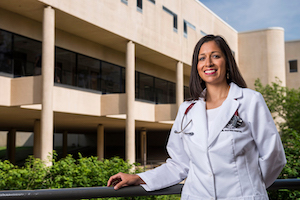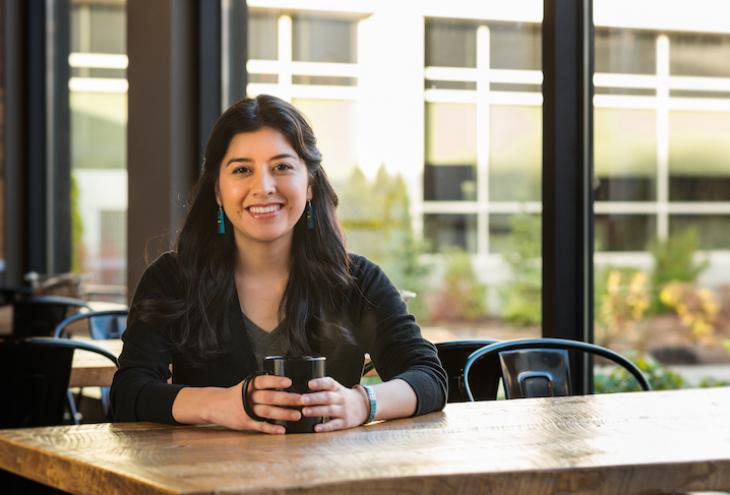All the companies on the Winds of Change Top 50 Workplaces for Indigenous STEM Professionals list are strong supporters of diversity. But what are these workplaces doing that sets them apart? Here, we’ve taken a closer look at three of these employers to highlight some of the ways they foster an inclusive climate at work and the initiatives they have put in place to support individual staff members. To get an even clearer picture of what being part of a diverse workplace can mean to an individual, we asked a Native American STEM professional at each of these organizations to describe his or her experiences.
Georgia Sandoval
Navajo
High Performance Architect
Intel
Zigzag. That’s the advice Georgia Sandoval, a high-performance architect at Intel, has for STEM students. “You think there’s only one path for you and if you fail, everything’s going to fall apart,” recalls Sandoval, 28. That’s when you learn to zigzag.
Sandoval bases that insight on her own story. “If you don’t get an internship, then try for a research opportunity,” she says. “If one path doesn’t work, try another until you get where you want to be. Nobody has a linear path in life.”
In high school in Tuba City, Ariz., Sandoval was often the only girl in math classes. Because she was shy, she never applied for extracurricular programs. “It was a lack of confidence,” she explains. “I didn’t think I’d get in any, so why bother?”
Things didn’t click until she was a junior at Arizona State University and took a coding class. “I really loved it,” she says. A year later, she graduated with a degree in computational mathematics.
Today, after stints at Boeing and Raytheon, she’s at Intel helping create the world’s first exascale computer. Able to perform a quintillion floating point computations per second, this new breed of ultra-supercomputer will help scientists model climate change, map the brain, and conduct advanced physics research.
Sandoval’s job involves making performance projections, a role that entails far more than crunching numbers. “We have brainstorming meetings throughout the day on how we’re going to solve the next problem,” she says, and collaborates with scientists from multiple national labs, who send her bundles of their code to evaluate.
Her Navajo heritage has guided and strengthened Sandoval along her path, which has not always been easy. She was a single mother in college who had to work her way from tribal college to community college and finally to Arizona State University. Being a role model for her child inspired her to finish her college degree.
“My parents continue to say, remember who you are, and remember who your people are, so you’re grounded,” says Sandoval.
She has a special fondness for her masani (her mother’s mother) who told her, “The way to succeed in this new world of technology is to use your brain, study, and always walk on dirt to remember where you came from.” Sandoval offers that advice to today’s students: “Find the balance between culture and modern society, without sacrificing your core identity.”
Above all, she wants students to remember they’re not alone. “In college I was pushed to network, even when I didn’t want to,” she recalls. “But I made sure to be myself. People can see when you’re faking it. Explore new areas — there are so many opportunities out there.”
Succeeding in college networking was a big step from her days as a shy high school student. She wishes that back then she had learned an important lesson. “It is okay to admit you need help, to admit you’re scared,” she explains. “The most important thing is to talk to someone, to ask for help — to figure out what you want and build your confidence.”
Georgia Sandoval has come a long way. “I was always the quiet girl in the corner,” she says. “I’m far from that now.”
—by George Spencer
Thérèse E. Dugan
Cherokee Nation
AI Data and Tools User Experience Research Lead
The Facebook Company
For the past 18 years Thérèse Dugan has had a ringside seat at the intersection of education, entertainment, and emerging technologies. Her role is now AI data and tools user experience research lead at the Facebook company, but Dugan’s career has included child-computer interaction research, learning science and research, and television production — she won an Emmy in 2002.
After several years at Oklahoma City’s PBS station, Dugan was inspired by letters she received from viewers. “Our shows were helping them learn and change their opinion on issues like gay marriage, adoption, and tribal sovereignty,” says Dugan, a member of the Cherokee Nation. “I wanted to know more about how media can help people learn, so I went back to graduate school for my degree in learning science and human development.” Dugan’s PhD dissertation showcased joint media engagement, a new conceptualization of co-viewing for young children.
Dugan moved to a postdoctoral fellowship at Nokia Research Center in Palo Alto, Calif., where she put theory into practice by developing products with emerging technologies. That led to a position at Intel. “I conducted foundational research at Intel and drove strategy and future product innovations for the educational market,” she says. “This included numerous projects in emerging technologies such as 3D/ depth cameras, wearables, speech recognition, augmented and virtual reality, and affective computing.” (Affective computing involves bridging the gap between human emotions and computational technology.)
While at Intel, Dugan also mentored early-stage educational start-up companies through the Intel Education Accelerator program. That work dovetails with one of Dugan’s passions: advocating for women in STEAM (science, technology, engineering, the arts, and math). “When I was at Intel I created some products for MGA Entertainment and worked as a science consultant for a new transmedia franchise of dolls, science kits, and a Netflix/DreamWorks/Awesomeness TV show targeted to girls ages five to 10,” says Dugan. “It followed six young girls who solved problems for the world through science.” In two episodes Dugan even portrayed a character who works in product design to solve the world’s problems. “I was flattered to serve as a role model for the show’s young audience,” says Dugan, who received a nomination for a Daytime Emmy for Outstanding Children’s Series in 2016.
At Facebook, Dugan uses all these talents in her role in artificial intelligence. “Understanding how people learn and understand information at a cognitive level is essential in helping teams build accessible features, strategize about product roadmaps, and ensure we have the right technology for future innovations in emerging technology,” Dugan says. “My role is to help Facebook be more inclusive for all our users.”
She has discovered that Facebook is a great place for Native people to work, with a strong Native community called Native@. “This provides a safe space to share with our relatives and promote actionable causes that are important to us in and outside work,” Dugan says. “At Facebook we have an internal tool called Workplace that allows us instant connections to all the other Indigenous members of Facebook.” Facebook also offers professional development, lectures, mentorships, and speaking opportunities. Dugan appreciates being able to attend one conference each year just to build professional skills. And then, there are the free meals. “That’s awesome in itself,” she says, “but it provides a wonderful atmosphere where teams talk and share and build community.”
Dugan’s sense of Native community extends beyond the workplace. “I am proud of the Cherokee Nation’s determination to be heard in the U.S. government,” Dugan says. The Cherokee Nation has a treaty right to representation in Congress, and in 2019, she says, they used that right to send a delegate to the House of Representatives.
Dugan also serves on several boards as part of her ultimate career goal: “Mentor and manage others so I can help develop the next generation of researchers and scientists.”
—by Debra Utacia Krol
 Dr. Emma Harp
Dr. Emma Harp
Cherokee Nation
Osteopathic Physician
As a student at Westville High School in Oklahoma, Dr. Emma Harp used her spare time to learn about the world of healing instead of participating in more typical extracurriculars. “I especially loved human anatomy and physiology,” she says. “This led me to spend school breaks in various health professional offices to help figure out what I really felt called to do.”
She discovered that calling before she finished her first year of college. “While job shadowing a family physician at the Wilma P. Mankiller Clinic, I fell in love with my current career,” she says. “I loved being able to encourage patients to live healthy lives and promote preventative and early detection services.”
After Dr. Harp earned her undergraduate degree in biology from Northeastern State University, she attended the Oklahoma State University College of Osteopathic Medicine and completed her residency at the OSU Tahlequah Campus. She was especially drawn to osteopathic medicine because of its emphasis on holistic care. “As a Cherokee citizen, treating the ‘whole’ person felt natural for me,” she explains. “While my medication management still remains very much traditionally Western medicine, I treat several patients who utilize Native medicine and who enjoy tribal dishes, like traditional greens, which can sometimes interact with their medication regimens.”
As a Cherokee osteopathic physician, Dr. Harp feels she is able to hold a more respectful conversation with her patients about any risks with those interactions. “I understand the importance of traditional medicine to those people, and I want to utilize those medicines while keeping my patients safe and aware of any risk,” she says.
If a patient mentions a different option that includes traditional medicine, she says she is happy to explore that possibility. “I often find myself in a discussion about our ancestors, their lifestyle, food, and activities,” she says. “It really helps put things in perspective for most patients.”
During her years in college, then as a medical student, and ultimately as a resident, Dr. Harp rotated through Cherokee Nation clinics. Now, as a physician, Dr. Harp has been working for the Cherokee Nation for several years. “I absolutely love taking care of tribal citizens. I really connect with them, and vice versa,” she says. “We grew up in the same communities with the same values and experiences. That connection helps build so much trust and is really the epitome of what you want in a patient-physician relationship.”
Dr. Harp credits her passion for caring for her community to the time she spent with her grandparents growing up. “My grandmother was very selfless and cared for those around her,” she says. Now, with four children of her own, Dr. Harp understands the value of community role models. “It is important for Native youth to see other Natives succeed in the field of their choice,” she says. “It plants a seed that reassures that child that their dream can come true.”
—by Vincent Schilling
THE 2020 LIST OF TOP 50 WORKPLACES FOR INDIGENOUS STEM PROFESSIONALS
(IN ALPHABETICAL ORDER)*
3M
Accenture
Amazon
American Chemical Society
America’s Navy
AT&T
BMM Testlabs
BNSF Railway
The Boeing Company
Bonneville Power Administration
Boston Scientific
Bristol Bay Native Corporation
Bureau of Ocean Energy Management
Central Intelligence Agency qCherokee Nation Human
Resources
Chevron
Comcast NBCUniversal
ExxonMobil
Facebook
Fiat Chrysler Automobiles
GE Aviation
General Motors
IBM
Intel
Mayo Clinic
Merck
Microsoft
National Aeronautics and Space Administration
National Security Agency qNavajo Nation Division of
Natural Resources
Navajo Transitional Energy Company
NextEra Energy qNIKE, Inc. qNorthrop Grumman
Oracle
Procter & Gamble
Raytheon
Sandia National Laboratories
Stantec
UPS
U.S. Air Force/Air Force Civilian Service
U.S. Army Corps of Engineers
U.S. Department of Energy
U.S. Department of State
U.S. Nuclear Regulatory Commission
USDA Agricultural Research Service
USDA Forest Service
USDA Natural Resources
Conservation Service
VGT, an Aristocrat company qWells Fargo











